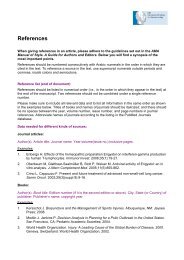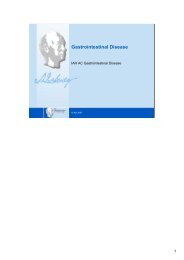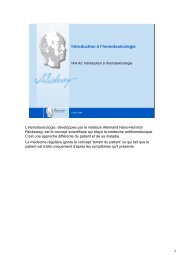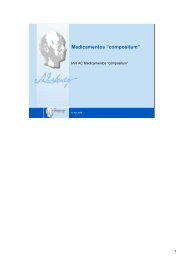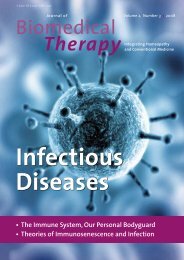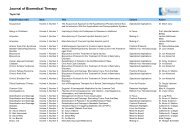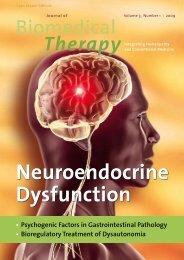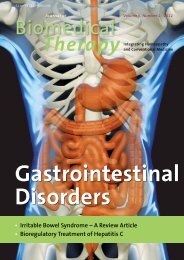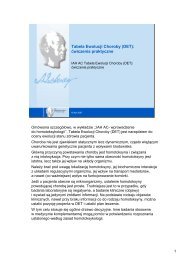Metabolic Syndrome - International Academy of Homotoxicology
Metabolic Syndrome - International Academy of Homotoxicology
Metabolic Syndrome - International Academy of Homotoxicology
Create successful ePaper yourself
Turn your PDF publications into a flip-book with our unique Google optimized e-Paper software.
) In Focus<br />
<strong>Metabolic</strong> <strong>Syndrome</strong><br />
By Pr<strong>of</strong>. Michael F. Kirkman, MD<br />
Chartered Biologist (Institute <strong>of</strong> Biology, London)<br />
Fellow Royal Institute <strong>of</strong> Public Health (London)<br />
Principal, <strong>Academy</strong> <strong>of</strong> <strong>Homotoxicology</strong> and Bio-Regulatory Medicine (States <strong>of</strong> Jersey)<br />
Director <strong>of</strong> Academic Affairs, The Society for <strong>Homotoxicology</strong> and Antihomotoxic Therapy (Great Britain)<br />
“Structure Is an Expression <strong>of</strong> Function.”<br />
Epidemiologic key factors<br />
relating to metabolic syndrome<br />
) 4<br />
Introduction<br />
The term “metabolic syndrome” denotes<br />
a constellation <strong>of</strong> cardiovascular<br />
risk factors related to insulin resistance<br />
and obesity with a visceral<br />
fat pattern. 1(p741),2 Definitions have<br />
varied, but the basic elements are<br />
well validated and include insulin<br />
resistance, inflammation, and immunologic<br />
dysfunction with increased<br />
oxidative stress preceding the accepted<br />
characteristics <strong>of</strong> hypertension,<br />
atherogenic dyslipidemia (high<br />
triglycerides, low HDL, high LDL),<br />
obesity (increased waist circumference,<br />
BMI, and waist-hip ratio),<br />
together with elevated fasting blood<br />
sugar level, glucose intolerance, hyperglycemia,<br />
and a prothrombotic<br />
state (see Table 1).<br />
Although the exact criteria vary between<br />
the two key determinant projections<br />
(National Cholesterol Education<br />
Programme – Adult Treatment<br />
Panel III [NCEP ATP III] and World<br />
Health Organization [WHO]), the<br />
criteria correlate closely.<br />
Interestingly, the WHO includes microalbuminuria<br />
(overnight urinary<br />
albumin excretion rate > 20 μg/<br />
min), which the author believes is<br />
significant in relation to the inflammation/oxidative<br />
stress element and<br />
the fact that glucotoxicity and lipotoxicity<br />
induce changes in cell signaling,<br />
protein expression, gene expression,<br />
and free radical formation.<br />
These may be relevant to associated<br />
pathophysiological factors (prothrombotic<br />
components, vascular<br />
endothelial dysfunction, and accelerated<br />
athero-embolic conditions)<br />
and are undoubtedly related to an<br />
imbalance in vascular endothelial<br />
mediators, which results in excess<br />
angiotensin II and nitric oxide deficiency.<br />
Hence, vasoconstriction, prothrombotic,<br />
pro in flammatory, and<br />
pro-oxidant states ensue. 1(p741),2<br />
Abdominal obesity<br />
Triglycerides<br />
HDL cholesterol<br />
Blood pressure<br />
Fasting glucose<br />
• men<br />
• women<br />
• men<br />
• women<br />
Table 1: ATP III criteria for diagnosing metabolic syndrome<br />
Here we first need to mention the<br />
genetic predisposition <strong>of</strong> an individual.<br />
Gestational diabetes is a risk<br />
factor, and so may be bottle feeding.<br />
Lifestyle factors also play a role in<br />
this context. To begin with dietary<br />
habits, the consumption <strong>of</strong> white<br />
sugar (Pr<strong>of</strong>essor Yudkin’s “pure,<br />
white, and deadly”) and other high<br />
calorie foods, especially refined carbohydrates<br />
and those <strong>of</strong> high glycemic<br />
index, stand paramount. Reduced<br />
physical activity, particularly<br />
in adolescence, and an imbalanced<br />
microbial gut flora will also contribute<br />
to the development <strong>of</strong> metabolic<br />
syndrome.<br />
Minor factors seem to be elevated<br />
homocysteine levels (> 5 μg/L), ab-<br />
> 102 cm (40 in)<br />
> 88 cm (35 in)<br />
≥ 150 mg/dL<br />
< 40 mg/dL<br />
< 50 mg/dL<br />
≥ 130/≥ 85 mm Hg<br />
≥ 110 mg/dL<br />
Diagnosis <strong>of</strong> metabolic syndrome is made when 3 or more <strong>of</strong> the above risk determinants<br />
are present<br />
Journal <strong>of</strong> Biomedical Therapy 2008 ) Vol. 2, No. 1



